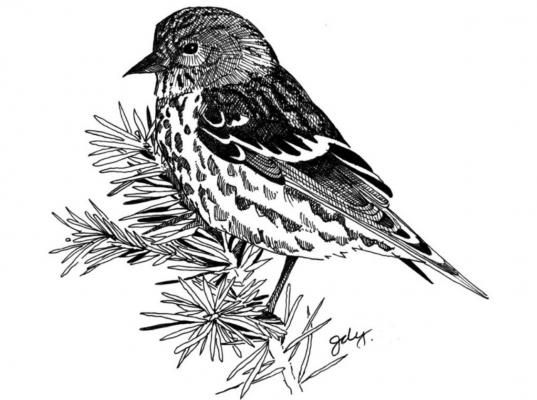Those little birds under the feeder
The Scott’s Orioles and Black-chinned hummingbirds have long since moved south. The kingbirds and swallows are gone, and Common Poorwills no longer call in the evenings. The warblers and flycatchers that paused for a brief rest in your yard during September and October are now on their wintering grounds far away.
You may have been maintaining a sunflower seed feeder through the summer or scattering some mixed seen on the ground for the ubiquitous House Finches and White-winged Doves, but now it’s time to think about the new arrivals.
Winter in West Texas can mean temperatures in the teens, or the mercury may soar into the 70s, but it always brings those strange little birds under the feeder that we just don’t see any other time of year.
Dark-eyed Juncos and Chipping and White-crowned sparrows join the doves and finches.
But to me, the harbinger of winter in West Texas is the arrival of the tiny Pine Siskin.
This diminutive brown bird with its yellow wing stripes and rising, buzzy flight call belongs in the genus Carduelis, which includes American and Lesser goldfinches and the redpolls. Its species, pinus, indicates the bird’s affinity for coniferous woodlands.
Often called the gypsies of the bird world, they wander most of the year in noisy flocks of up to 200 birds, pausing only long enough to breed and raise their young. Then they resume their roving ways.
The species’ summer range extends from the northernmost forests of eastern Alaska, across southern Canada and the Northern Tier into New England, and down the Rocky Mountains and Pacific Coast.
They nest in conifers and feed primarily on tree and weed seeds. In winter Pine Siskins may be found through the continental U.S. in greater or lesser numbers, with the exception of the southern half of Florida.
Pine Siskin is considered an irruptive species, that is, an irregular southward autumn/winter invasion by normally northern seeding eating birds. Ornithologists generally concur that irruptions are triggered by food shortages over a large geographic area.
Years of good crops, which presumably result in higher breeding rates, are often followed by years with poor crops. Thus, a year of crop failure that follows one of abundant seeds and higher bird populations puts pressure on the birds to migrate in larger numbers and farther afield than they might otherwise.
Pine Siskins normally winter throughout Texas in good numbers, irruption or not. Flocks of 50 or more descend on my backyard bird feeders each winter, and when the early stragglers arrive in mid-October, I know it’s time to get out the thistle feeder.
Siskins feed enthusiastically at backyard feeding stations, and will squabble noisily for position at one stocked with their much-favored niger seed. Niger - colloquially called thistle - is a tiny black import from India and Africa that requires a special feeder with tiny holes. The siskins can remove the seeds with their slender, pointed bills, but larger birds can’t feed easily through the smaller holes.
Don’t put niger in your regular sunflower feeders - it will flow right through the large feeding ports and onto the ground. Most stores that sell birdseed also carry niger feeders.
It’s more expensive than standard mixed birdseed or sunflower seed, but you can purchase a prepackaged finch mix which contains around 50 percent niger and 50 percent other small seeds such as black lettuce, German millet, and canary seed, along with finely chipped, hulled sunflower seed. It’s a bit cheaper than pure niger, and the siskins seem to enjoy it equally.
Other small birds such as American and Lesser goldfinches also frequent thistle feeders, and in other places I’ve lived, chickadees loved the stuff!
Although they don’t alight on hanging feeders, many other small wintering birds forage on the ground below gleaning the leftovers. Juncos and sparrows in particular are drawn to the seed, and you might catch one darting out from among the weeds to snatch a meal.
If you don’t have one already, try a thistle feeder this winter – you’ll be rewarded with hours of avian entertainment.
Questions or comments? You may email Gail at gdyovan@gmail.com.




